Postoperative Case Study Analysis: Nursing Interventions and Drugs
VerifiedAdded on 2022/07/28
|10
|3158
|27
Case Study
AI Summary
This assignment presents a comprehensive analysis of a postoperative case study, focusing on a patient named Ted. The analysis begins by considering the biopsychosocial, spiritual, and cultural impacts of Ted's surgery on him and his family, utilizing the RLT model. It then meticulously examines the collected data, linking the patient's symptoms – including high heart rates, blood pressure, nausea, and respiratory issues – to relevant pathophysiology and providing evidence-based support from literature. The study identifies and justifies five nursing care interventions, emphasizing the importance of patient monitoring, pain management, and fluid balance. Finally, the assignment explores two crucial classes of drugs used in postoperative care, specifically those addressing pain, nausea, and vomiting, providing insights into their mechanisms and implications for patient outcomes. The analysis references several research articles to support the findings and recommendations.
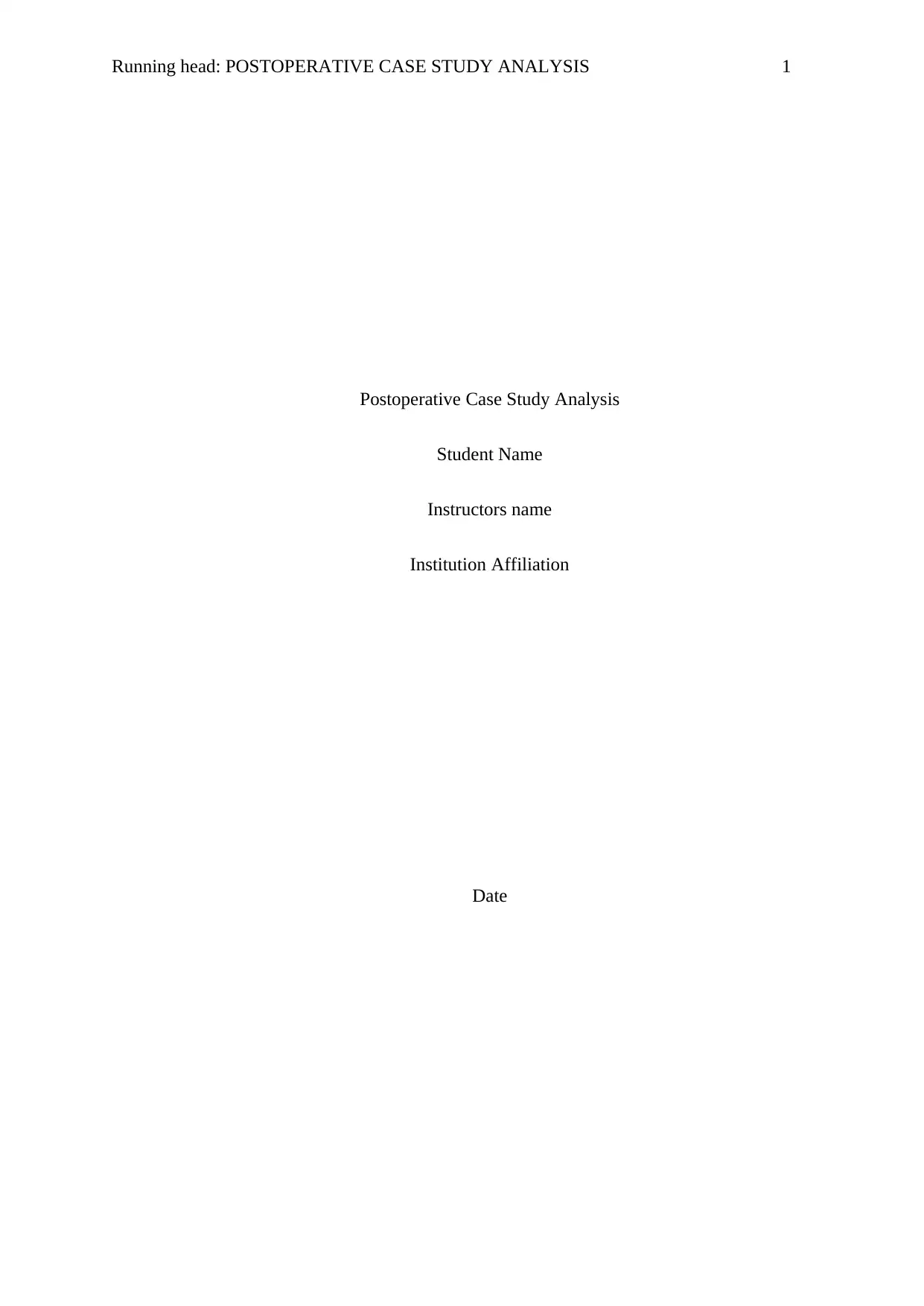
Running head: POSTOPERATIVE CASE STUDY ANALYSIS 1
Postoperative Case Study Analysis
Student Name
Instructors name
Institution Affiliation
Date
Postoperative Case Study Analysis
Student Name
Instructors name
Institution Affiliation
Date
Paraphrase This Document
Need a fresh take? Get an instant paraphrase of this document with our AI Paraphraser
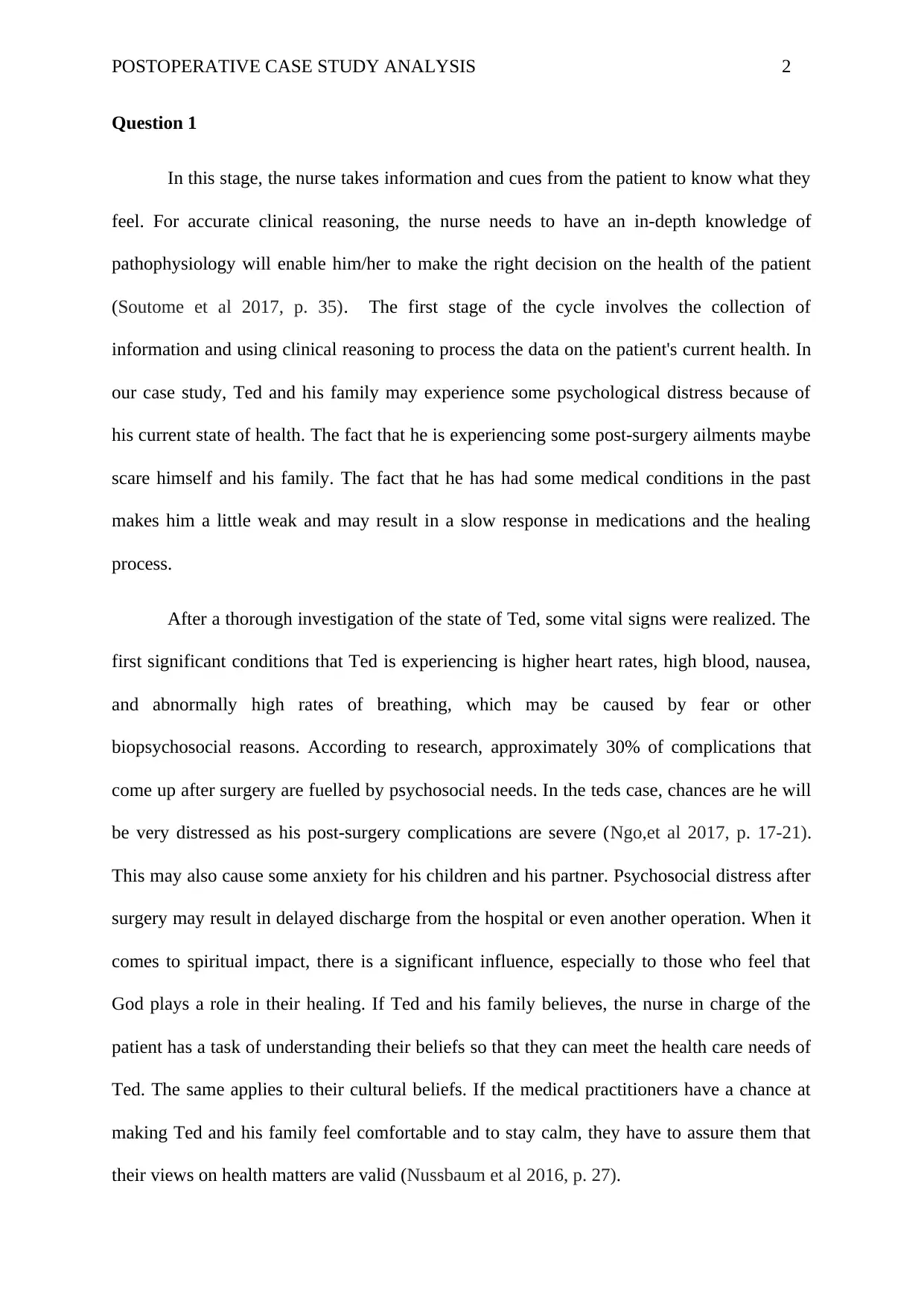
POSTOPERATIVE CASE STUDY ANALYSIS 2
Question 1
In this stage, the nurse takes information and cues from the patient to know what they
feel. For accurate clinical reasoning, the nurse needs to have an in-depth knowledge of
pathophysiology will enable him/her to make the right decision on the health of the patient
(Soutome et al 2017, p. 35). The first stage of the cycle involves the collection of
information and using clinical reasoning to process the data on the patient's current health. In
our case study, Ted and his family may experience some psychological distress because of
his current state of health. The fact that he is experiencing some post-surgery ailments maybe
scare himself and his family. The fact that he has had some medical conditions in the past
makes him a little weak and may result in a slow response in medications and the healing
process.
After a thorough investigation of the state of Ted, some vital signs were realized. The
first significant conditions that Ted is experiencing is higher heart rates, high blood, nausea,
and abnormally high rates of breathing, which may be caused by fear or other
biopsychosocial reasons. According to research, approximately 30% of complications that
come up after surgery are fuelled by psychosocial needs. In the teds case, chances are he will
be very distressed as his post-surgery complications are severe (Ngo,et al 2017, p. 17-21).
This may also cause some anxiety for his children and his partner. Psychosocial distress after
surgery may result in delayed discharge from the hospital or even another operation. When it
comes to spiritual impact, there is a significant influence, especially to those who feel that
God plays a role in their healing. If Ted and his family believes, the nurse in charge of the
patient has a task of understanding their beliefs so that they can meet the health care needs of
Ted. The same applies to their cultural beliefs. If the medical practitioners have a chance at
making Ted and his family feel comfortable and to stay calm, they have to assure them that
their views on health matters are valid (Nussbaum et al 2016, p. 27).
Question 1
In this stage, the nurse takes information and cues from the patient to know what they
feel. For accurate clinical reasoning, the nurse needs to have an in-depth knowledge of
pathophysiology will enable him/her to make the right decision on the health of the patient
(Soutome et al 2017, p. 35). The first stage of the cycle involves the collection of
information and using clinical reasoning to process the data on the patient's current health. In
our case study, Ted and his family may experience some psychological distress because of
his current state of health. The fact that he is experiencing some post-surgery ailments maybe
scare himself and his family. The fact that he has had some medical conditions in the past
makes him a little weak and may result in a slow response in medications and the healing
process.
After a thorough investigation of the state of Ted, some vital signs were realized. The
first significant conditions that Ted is experiencing is higher heart rates, high blood, nausea,
and abnormally high rates of breathing, which may be caused by fear or other
biopsychosocial reasons. According to research, approximately 30% of complications that
come up after surgery are fuelled by psychosocial needs. In the teds case, chances are he will
be very distressed as his post-surgery complications are severe (Ngo,et al 2017, p. 17-21).
This may also cause some anxiety for his children and his partner. Psychosocial distress after
surgery may result in delayed discharge from the hospital or even another operation. When it
comes to spiritual impact, there is a significant influence, especially to those who feel that
God plays a role in their healing. If Ted and his family believes, the nurse in charge of the
patient has a task of understanding their beliefs so that they can meet the health care needs of
Ted. The same applies to their cultural beliefs. If the medical practitioners have a chance at
making Ted and his family feel comfortable and to stay calm, they have to assure them that
their views on health matters are valid (Nussbaum et al 2016, p. 27).
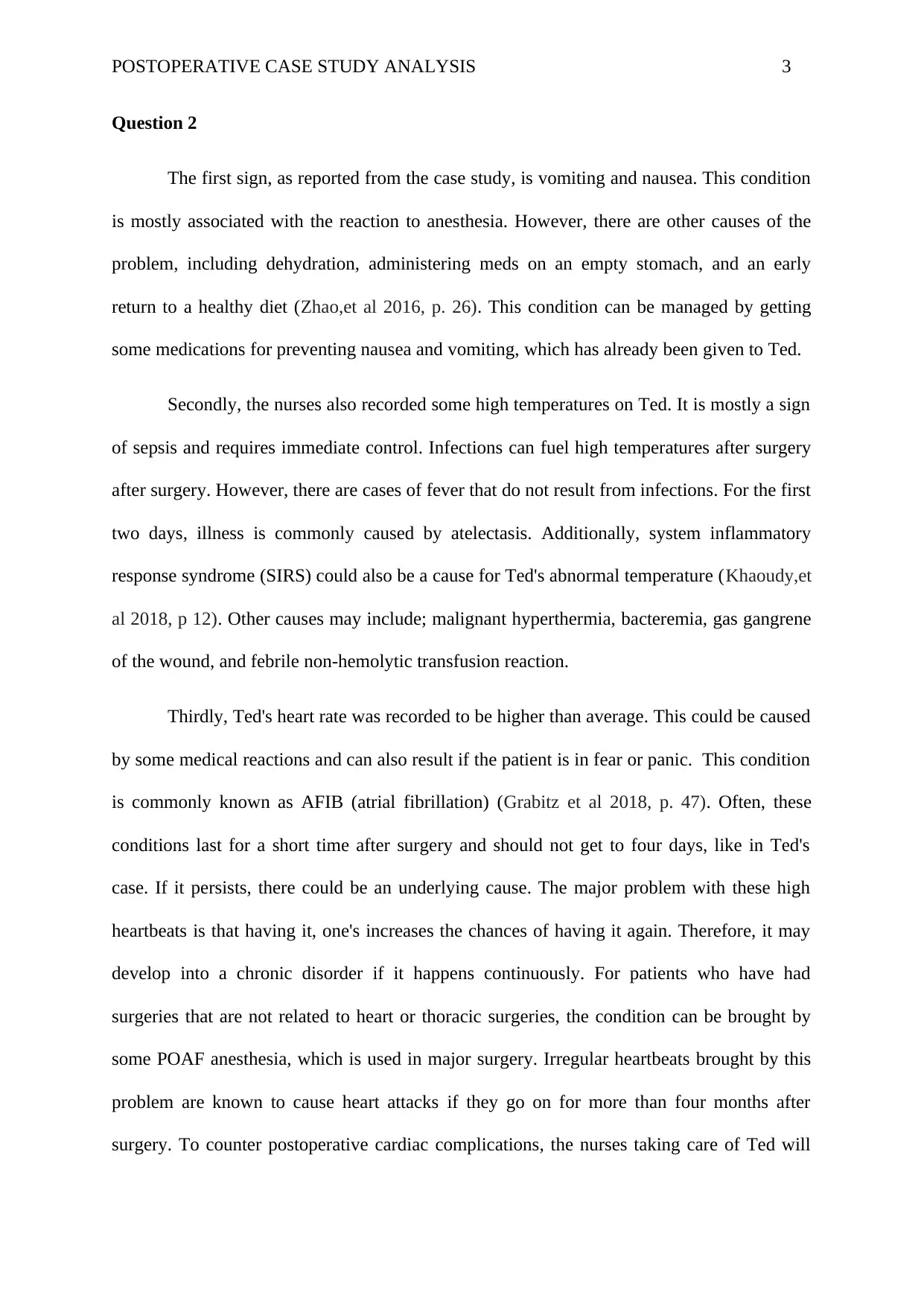
POSTOPERATIVE CASE STUDY ANALYSIS 3
Question 2
The first sign, as reported from the case study, is vomiting and nausea. This condition
is mostly associated with the reaction to anesthesia. However, there are other causes of the
problem, including dehydration, administering meds on an empty stomach, and an early
return to a healthy diet (Zhao,et al 2016, p. 26). This condition can be managed by getting
some medications for preventing nausea and vomiting, which has already been given to Ted.
Secondly, the nurses also recorded some high temperatures on Ted. It is mostly a sign
of sepsis and requires immediate control. Infections can fuel high temperatures after surgery
after surgery. However, there are cases of fever that do not result from infections. For the first
two days, illness is commonly caused by atelectasis. Additionally, system inflammatory
response syndrome (SIRS) could also be a cause for Ted's abnormal temperature (Khaoudy,et
al 2018, p 12). Other causes may include; malignant hyperthermia, bacteremia, gas gangrene
of the wound, and febrile non-hemolytic transfusion reaction.
Thirdly, Ted's heart rate was recorded to be higher than average. This could be caused
by some medical reactions and can also result if the patient is in fear or panic. This condition
is commonly known as AFIB (atrial fibrillation) (Grabitz et al 2018, p. 47). Often, these
conditions last for a short time after surgery and should not get to four days, like in Ted's
case. If it persists, there could be an underlying cause. The major problem with these high
heartbeats is that having it, one's increases the chances of having it again. Therefore, it may
develop into a chronic disorder if it happens continuously. For patients who have had
surgeries that are not related to heart or thoracic surgeries, the condition can be brought by
some POAF anesthesia, which is used in major surgery. Irregular heartbeats brought by this
problem are known to cause heart attacks if they go on for more than four months after
surgery. To counter postoperative cardiac complications, the nurses taking care of Ted will
Question 2
The first sign, as reported from the case study, is vomiting and nausea. This condition
is mostly associated with the reaction to anesthesia. However, there are other causes of the
problem, including dehydration, administering meds on an empty stomach, and an early
return to a healthy diet (Zhao,et al 2016, p. 26). This condition can be managed by getting
some medications for preventing nausea and vomiting, which has already been given to Ted.
Secondly, the nurses also recorded some high temperatures on Ted. It is mostly a sign
of sepsis and requires immediate control. Infections can fuel high temperatures after surgery
after surgery. However, there are cases of fever that do not result from infections. For the first
two days, illness is commonly caused by atelectasis. Additionally, system inflammatory
response syndrome (SIRS) could also be a cause for Ted's abnormal temperature (Khaoudy,et
al 2018, p 12). Other causes may include; malignant hyperthermia, bacteremia, gas gangrene
of the wound, and febrile non-hemolytic transfusion reaction.
Thirdly, Ted's heart rate was recorded to be higher than average. This could be caused
by some medical reactions and can also result if the patient is in fear or panic. This condition
is commonly known as AFIB (atrial fibrillation) (Grabitz et al 2018, p. 47). Often, these
conditions last for a short time after surgery and should not get to four days, like in Ted's
case. If it persists, there could be an underlying cause. The major problem with these high
heartbeats is that having it, one's increases the chances of having it again. Therefore, it may
develop into a chronic disorder if it happens continuously. For patients who have had
surgeries that are not related to heart or thoracic surgeries, the condition can be brought by
some POAF anesthesia, which is used in major surgery. Irregular heartbeats brought by this
problem are known to cause heart attacks if they go on for more than four months after
surgery. To counter postoperative cardiac complications, the nurses taking care of Ted will
⊘ This is a preview!⊘
Do you want full access?
Subscribe today to unlock all pages.

Trusted by 1+ million students worldwide
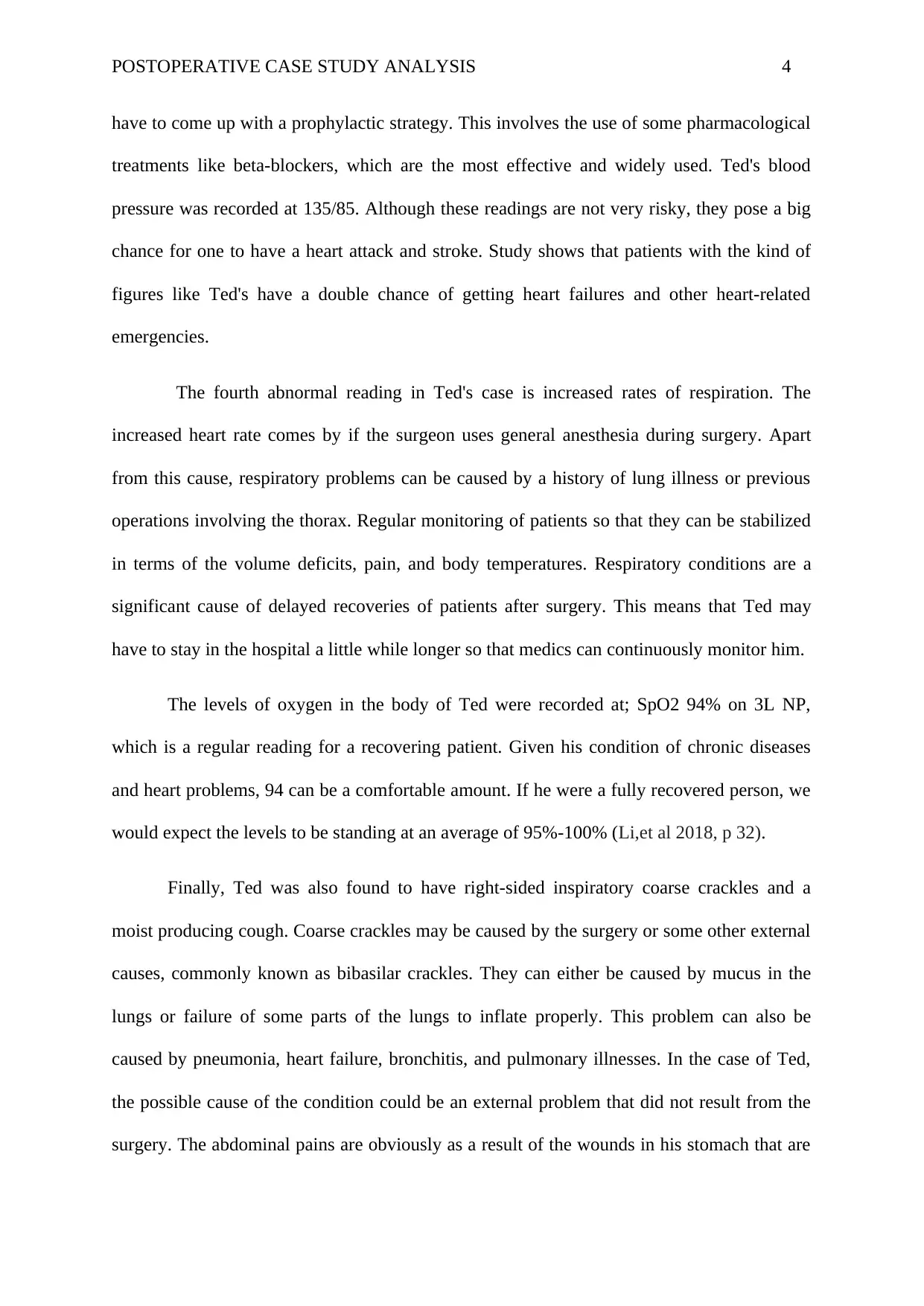
POSTOPERATIVE CASE STUDY ANALYSIS 4
have to come up with a prophylactic strategy. This involves the use of some pharmacological
treatments like beta-blockers, which are the most effective and widely used. Ted's blood
pressure was recorded at 135/85. Although these readings are not very risky, they pose a big
chance for one to have a heart attack and stroke. Study shows that patients with the kind of
figures like Ted's have a double chance of getting heart failures and other heart-related
emergencies.
The fourth abnormal reading in Ted's case is increased rates of respiration. The
increased heart rate comes by if the surgeon uses general anesthesia during surgery. Apart
from this cause, respiratory problems can be caused by a history of lung illness or previous
operations involving the thorax. Regular monitoring of patients so that they can be stabilized
in terms of the volume deficits, pain, and body temperatures. Respiratory conditions are a
significant cause of delayed recoveries of patients after surgery. This means that Ted may
have to stay in the hospital a little while longer so that medics can continuously monitor him.
The levels of oxygen in the body of Ted were recorded at; SpO2 94% on 3L NP,
which is a regular reading for a recovering patient. Given his condition of chronic diseases
and heart problems, 94 can be a comfortable amount. If he were a fully recovered person, we
would expect the levels to be standing at an average of 95%-100% (Li,et al 2018, p 32).
Finally, Ted was also found to have right-sided inspiratory coarse crackles and a
moist producing cough. Coarse crackles may be caused by the surgery or some other external
causes, commonly known as bibasilar crackles. They can either be caused by mucus in the
lungs or failure of some parts of the lungs to inflate properly. This problem can also be
caused by pneumonia, heart failure, bronchitis, and pulmonary illnesses. In the case of Ted,
the possible cause of the condition could be an external problem that did not result from the
surgery. The abdominal pains are obviously as a result of the wounds in his stomach that are
have to come up with a prophylactic strategy. This involves the use of some pharmacological
treatments like beta-blockers, which are the most effective and widely used. Ted's blood
pressure was recorded at 135/85. Although these readings are not very risky, they pose a big
chance for one to have a heart attack and stroke. Study shows that patients with the kind of
figures like Ted's have a double chance of getting heart failures and other heart-related
emergencies.
The fourth abnormal reading in Ted's case is increased rates of respiration. The
increased heart rate comes by if the surgeon uses general anesthesia during surgery. Apart
from this cause, respiratory problems can be caused by a history of lung illness or previous
operations involving the thorax. Regular monitoring of patients so that they can be stabilized
in terms of the volume deficits, pain, and body temperatures. Respiratory conditions are a
significant cause of delayed recoveries of patients after surgery. This means that Ted may
have to stay in the hospital a little while longer so that medics can continuously monitor him.
The levels of oxygen in the body of Ted were recorded at; SpO2 94% on 3L NP,
which is a regular reading for a recovering patient. Given his condition of chronic diseases
and heart problems, 94 can be a comfortable amount. If he were a fully recovered person, we
would expect the levels to be standing at an average of 95%-100% (Li,et al 2018, p 32).
Finally, Ted was also found to have right-sided inspiratory coarse crackles and a
moist producing cough. Coarse crackles may be caused by the surgery or some other external
causes, commonly known as bibasilar crackles. They can either be caused by mucus in the
lungs or failure of some parts of the lungs to inflate properly. This problem can also be
caused by pneumonia, heart failure, bronchitis, and pulmonary illnesses. In the case of Ted,
the possible cause of the condition could be an external problem that did not result from the
surgery. The abdominal pains are obviously as a result of the wounds in his stomach that are
Paraphrase This Document
Need a fresh take? Get an instant paraphrase of this document with our AI Paraphraser
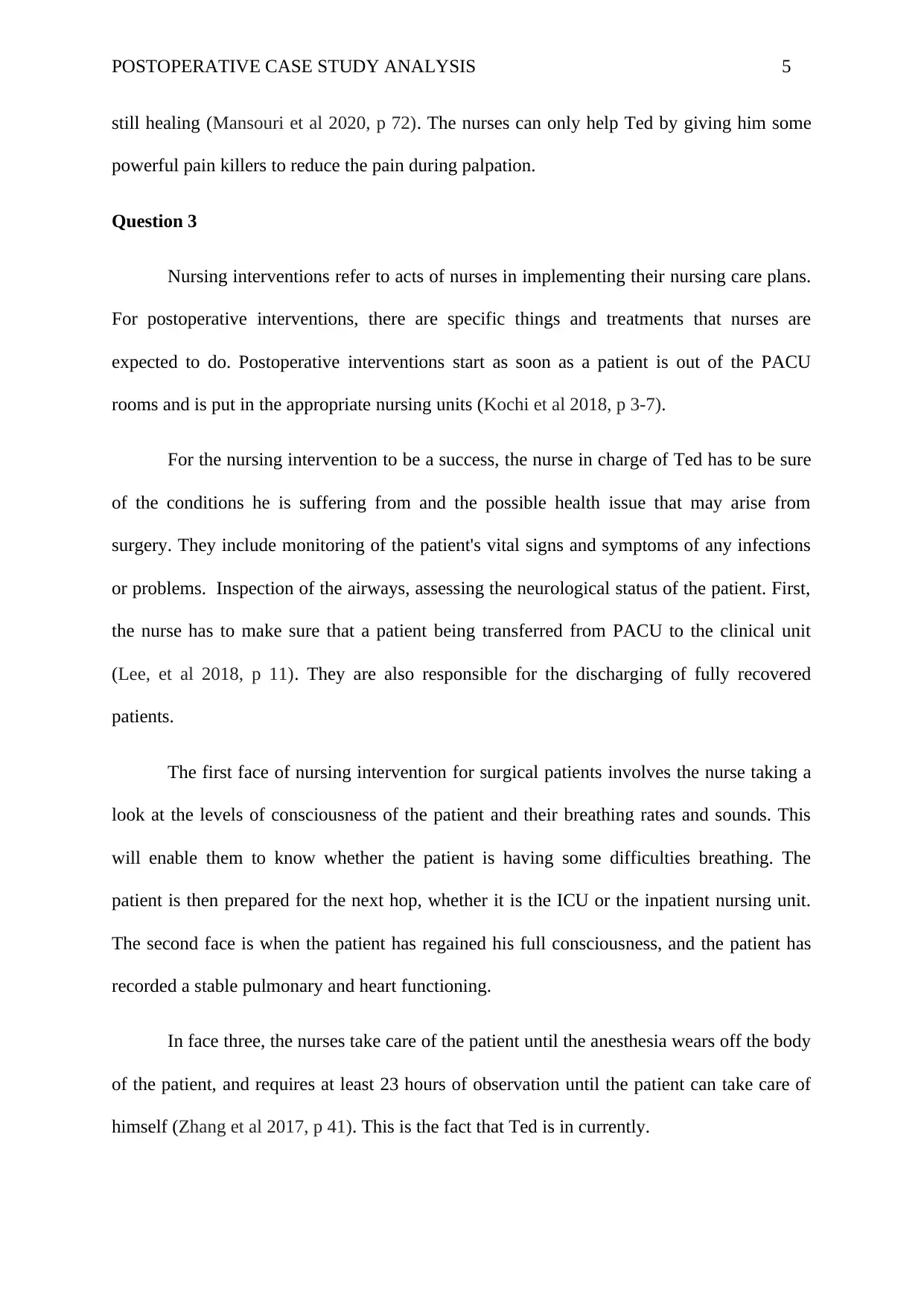
POSTOPERATIVE CASE STUDY ANALYSIS 5
still healing (Mansouri et al 2020, p 72). The nurses can only help Ted by giving him some
powerful pain killers to reduce the pain during palpation.
Question 3
Nursing interventions refer to acts of nurses in implementing their nursing care plans.
For postoperative interventions, there are specific things and treatments that nurses are
expected to do. Postoperative interventions start as soon as a patient is out of the PACU
rooms and is put in the appropriate nursing units (Kochi et al 2018, p 3-7).
For the nursing intervention to be a success, the nurse in charge of Ted has to be sure
of the conditions he is suffering from and the possible health issue that may arise from
surgery. They include monitoring of the patient's vital signs and symptoms of any infections
or problems. Inspection of the airways, assessing the neurological status of the patient. First,
the nurse has to make sure that a patient being transferred from PACU to the clinical unit
(Lee, et al 2018, p 11). They are also responsible for the discharging of fully recovered
patients.
The first face of nursing intervention for surgical patients involves the nurse taking a
look at the levels of consciousness of the patient and their breathing rates and sounds. This
will enable them to know whether the patient is having some difficulties breathing. The
patient is then prepared for the next hop, whether it is the ICU or the inpatient nursing unit.
The second face is when the patient has regained his full consciousness, and the patient has
recorded a stable pulmonary and heart functioning.
In face three, the nurses take care of the patient until the anesthesia wears off the body
of the patient, and requires at least 23 hours of observation until the patient can take care of
himself (Zhang et al 2017, p 41). This is the fact that Ted is in currently.
still healing (Mansouri et al 2020, p 72). The nurses can only help Ted by giving him some
powerful pain killers to reduce the pain during palpation.
Question 3
Nursing interventions refer to acts of nurses in implementing their nursing care plans.
For postoperative interventions, there are specific things and treatments that nurses are
expected to do. Postoperative interventions start as soon as a patient is out of the PACU
rooms and is put in the appropriate nursing units (Kochi et al 2018, p 3-7).
For the nursing intervention to be a success, the nurse in charge of Ted has to be sure
of the conditions he is suffering from and the possible health issue that may arise from
surgery. They include monitoring of the patient's vital signs and symptoms of any infections
or problems. Inspection of the airways, assessing the neurological status of the patient. First,
the nurse has to make sure that a patient being transferred from PACU to the clinical unit
(Lee, et al 2018, p 11). They are also responsible for the discharging of fully recovered
patients.
The first face of nursing intervention for surgical patients involves the nurse taking a
look at the levels of consciousness of the patient and their breathing rates and sounds. This
will enable them to know whether the patient is having some difficulties breathing. The
patient is then prepared for the next hop, whether it is the ICU or the inpatient nursing unit.
The second face is when the patient has regained his full consciousness, and the patient has
recorded a stable pulmonary and heart functioning.
In face three, the nurses take care of the patient until the anesthesia wears off the body
of the patient, and requires at least 23 hours of observation until the patient can take care of
himself (Zhang et al 2017, p 41). This is the fact that Ted is in currently.
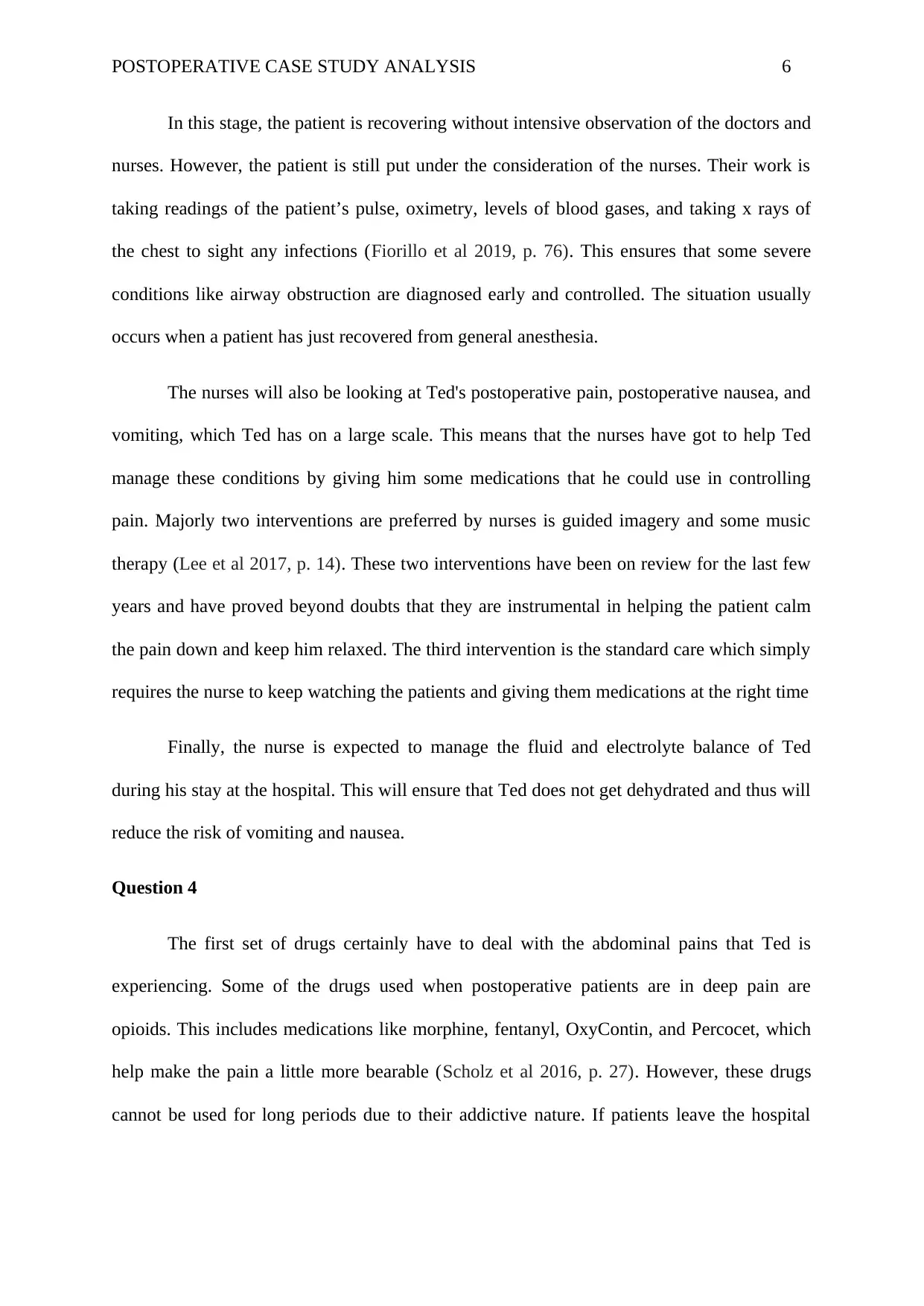
POSTOPERATIVE CASE STUDY ANALYSIS 6
In this stage, the patient is recovering without intensive observation of the doctors and
nurses. However, the patient is still put under the consideration of the nurses. Their work is
taking readings of the patient’s pulse, oximetry, levels of blood gases, and taking x rays of
the chest to sight any infections (Fiorillo et al 2019, p. 76). This ensures that some severe
conditions like airway obstruction are diagnosed early and controlled. The situation usually
occurs when a patient has just recovered from general anesthesia.
The nurses will also be looking at Ted's postoperative pain, postoperative nausea, and
vomiting, which Ted has on a large scale. This means that the nurses have got to help Ted
manage these conditions by giving him some medications that he could use in controlling
pain. Majorly two interventions are preferred by nurses is guided imagery and some music
therapy (Lee et al 2017, p. 14). These two interventions have been on review for the last few
years and have proved beyond doubts that they are instrumental in helping the patient calm
the pain down and keep him relaxed. The third intervention is the standard care which simply
requires the nurse to keep watching the patients and giving them medications at the right time
Finally, the nurse is expected to manage the fluid and electrolyte balance of Ted
during his stay at the hospital. This will ensure that Ted does not get dehydrated and thus will
reduce the risk of vomiting and nausea.
Question 4
The first set of drugs certainly have to deal with the abdominal pains that Ted is
experiencing. Some of the drugs used when postoperative patients are in deep pain are
opioids. This includes medications like morphine, fentanyl, OxyContin, and Percocet, which
help make the pain a little more bearable (Scholz et al 2016, p. 27). However, these drugs
cannot be used for long periods due to their addictive nature. If patients leave the hospital
In this stage, the patient is recovering without intensive observation of the doctors and
nurses. However, the patient is still put under the consideration of the nurses. Their work is
taking readings of the patient’s pulse, oximetry, levels of blood gases, and taking x rays of
the chest to sight any infections (Fiorillo et al 2019, p. 76). This ensures that some severe
conditions like airway obstruction are diagnosed early and controlled. The situation usually
occurs when a patient has just recovered from general anesthesia.
The nurses will also be looking at Ted's postoperative pain, postoperative nausea, and
vomiting, which Ted has on a large scale. This means that the nurses have got to help Ted
manage these conditions by giving him some medications that he could use in controlling
pain. Majorly two interventions are preferred by nurses is guided imagery and some music
therapy (Lee et al 2017, p. 14). These two interventions have been on review for the last few
years and have proved beyond doubts that they are instrumental in helping the patient calm
the pain down and keep him relaxed. The third intervention is the standard care which simply
requires the nurse to keep watching the patients and giving them medications at the right time
Finally, the nurse is expected to manage the fluid and electrolyte balance of Ted
during his stay at the hospital. This will ensure that Ted does not get dehydrated and thus will
reduce the risk of vomiting and nausea.
Question 4
The first set of drugs certainly have to deal with the abdominal pains that Ted is
experiencing. Some of the drugs used when postoperative patients are in deep pain are
opioids. This includes medications like morphine, fentanyl, OxyContin, and Percocet, which
help make the pain a little more bearable (Scholz et al 2016, p. 27). However, these drugs
cannot be used for long periods due to their addictive nature. If patients leave the hospital
⊘ This is a preview!⊘
Do you want full access?
Subscribe today to unlock all pages.

Trusted by 1+ million students worldwide
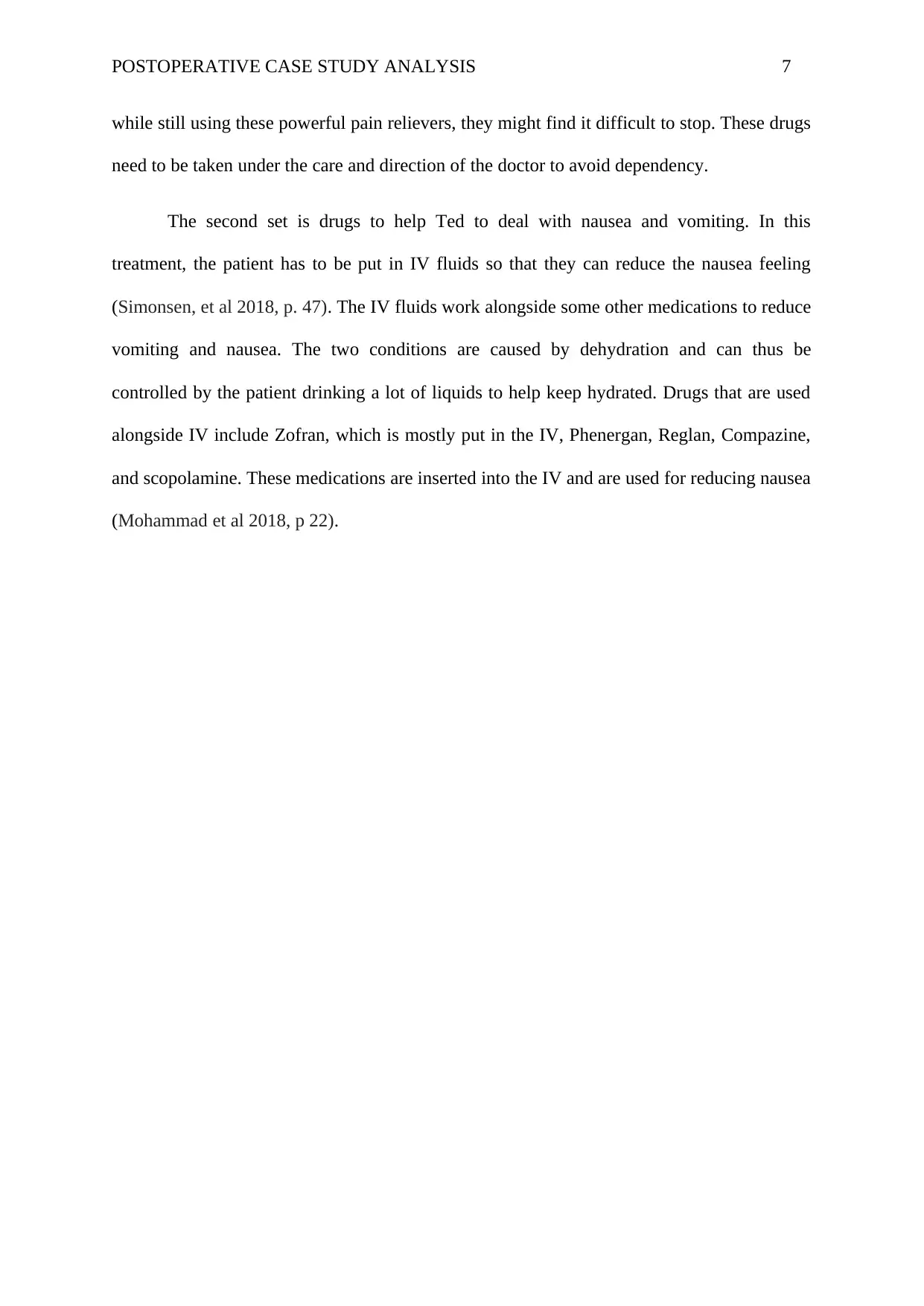
POSTOPERATIVE CASE STUDY ANALYSIS 7
while still using these powerful pain relievers, they might find it difficult to stop. These drugs
need to be taken under the care and direction of the doctor to avoid dependency.
The second set is drugs to help Ted to deal with nausea and vomiting. In this
treatment, the patient has to be put in IV fluids so that they can reduce the nausea feeling
(Simonsen, et al 2018, p. 47). The IV fluids work alongside some other medications to reduce
vomiting and nausea. The two conditions are caused by dehydration and can thus be
controlled by the patient drinking a lot of liquids to help keep hydrated. Drugs that are used
alongside IV include Zofran, which is mostly put in the IV, Phenergan, Reglan, Compazine,
and scopolamine. These medications are inserted into the IV and are used for reducing nausea
(Mohammad et al 2018, p 22).
while still using these powerful pain relievers, they might find it difficult to stop. These drugs
need to be taken under the care and direction of the doctor to avoid dependency.
The second set is drugs to help Ted to deal with nausea and vomiting. In this
treatment, the patient has to be put in IV fluids so that they can reduce the nausea feeling
(Simonsen, et al 2018, p. 47). The IV fluids work alongside some other medications to reduce
vomiting and nausea. The two conditions are caused by dehydration and can thus be
controlled by the patient drinking a lot of liquids to help keep hydrated. Drugs that are used
alongside IV include Zofran, which is mostly put in the IV, Phenergan, Reglan, Compazine,
and scopolamine. These medications are inserted into the IV and are used for reducing nausea
(Mohammad et al 2018, p 22).
Paraphrase This Document
Need a fresh take? Get an instant paraphrase of this document with our AI Paraphraser

POSTOPERATIVE CASE STUDY ANALYSIS 8
References
Fiorillo, C., Quero, G., Laterza, V., Mascagni, P., Longo, F., Menghi, R., ... & Giaccari, A.
(2019). Postoperative hyperglycemia affects survival after gastrectomy for cancer: A
single-center analysis using propensity score matching. Surgery.
Grabitz, S. D., Farhan, H. N., Ruscic, K. J., Timm, F. P., Shin, C. H., Thevathasan, T., ... &
Eikermann, M. (2017). Dose-dependent protective effect of inhalational anesthetics
against postoperative respiratory complications: a prospective analysis of data on file
from three hospitals in New England. Critical care medicine, 45(1), e30-e39.
Khaoudy, I., Farges, O., Boleslawski, E., Vibert, E., Soubrane, O., Adham, M., ... & Le
Treut, Y. P. (2018). Half of postoperative deaths after hepatectomy may be
preventable: a root-cause analysis of a prospective multicenter cohort study. Annals of
surgery, 268(5), 792-798.
Kochi, M., Hinoi, T., Niitsu, H., Ohdan, H., Konishi, F., Kinugasa, Y., ... & Ueki, T. (2018).
Risk factors for postoperative pneumonia in elderly patients with colorectal cancer: A
sub-analysis of a large, multicenter, case-control study in Japan. Surgery today, 48(8),
756-764.
Lee, H. K., Jin, R., Feng, Y., Bain, P. A., Goffinet, J., Baker, C., & Li, J. (2017, August).
Modeling and analysis of postoperative intervention process for total joint
replacement patients using simulations. In 2017 13th IEEE Conference on
Automation Science and Engineering (CASE) (pp. 568-573). IEEE.
References
Fiorillo, C., Quero, G., Laterza, V., Mascagni, P., Longo, F., Menghi, R., ... & Giaccari, A.
(2019). Postoperative hyperglycemia affects survival after gastrectomy for cancer: A
single-center analysis using propensity score matching. Surgery.
Grabitz, S. D., Farhan, H. N., Ruscic, K. J., Timm, F. P., Shin, C. H., Thevathasan, T., ... &
Eikermann, M. (2017). Dose-dependent protective effect of inhalational anesthetics
against postoperative respiratory complications: a prospective analysis of data on file
from three hospitals in New England. Critical care medicine, 45(1), e30-e39.
Khaoudy, I., Farges, O., Boleslawski, E., Vibert, E., Soubrane, O., Adham, M., ... & Le
Treut, Y. P. (2018). Half of postoperative deaths after hepatectomy may be
preventable: a root-cause analysis of a prospective multicenter cohort study. Annals of
surgery, 268(5), 792-798.
Kochi, M., Hinoi, T., Niitsu, H., Ohdan, H., Konishi, F., Kinugasa, Y., ... & Ueki, T. (2018).
Risk factors for postoperative pneumonia in elderly patients with colorectal cancer: A
sub-analysis of a large, multicenter, case-control study in Japan. Surgery today, 48(8),
756-764.
Lee, H. K., Jin, R., Feng, Y., Bain, P. A., Goffinet, J., Baker, C., & Li, J. (2017, August).
Modeling and analysis of postoperative intervention process for total joint
replacement patients using simulations. In 2017 13th IEEE Conference on
Automation Science and Engineering (CASE) (pp. 568-573). IEEE.
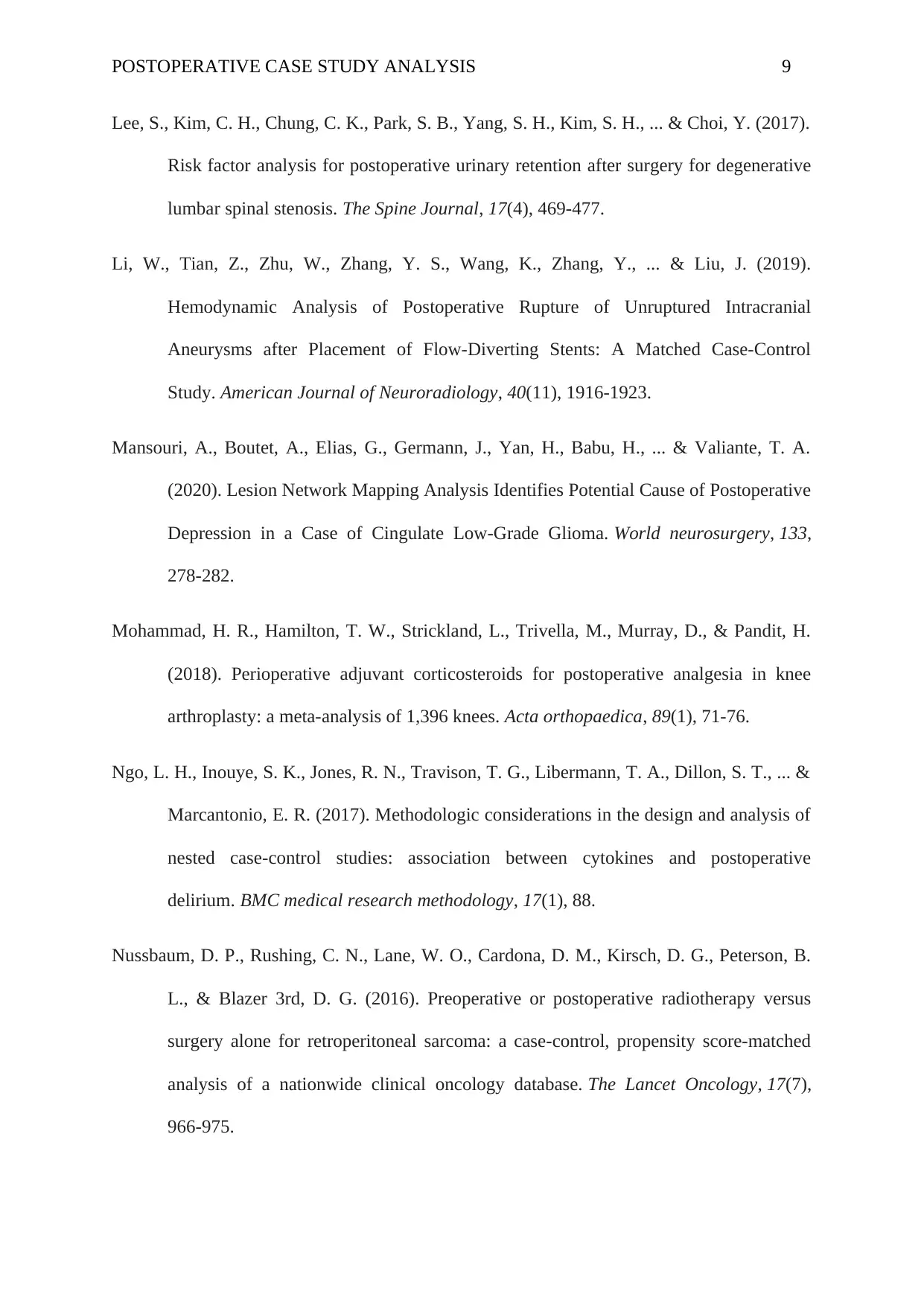
POSTOPERATIVE CASE STUDY ANALYSIS 9
Lee, S., Kim, C. H., Chung, C. K., Park, S. B., Yang, S. H., Kim, S. H., ... & Choi, Y. (2017).
Risk factor analysis for postoperative urinary retention after surgery for degenerative
lumbar spinal stenosis. The Spine Journal, 17(4), 469-477.
Li, W., Tian, Z., Zhu, W., Zhang, Y. S., Wang, K., Zhang, Y., ... & Liu, J. (2019).
Hemodynamic Analysis of Postoperative Rupture of Unruptured Intracranial
Aneurysms after Placement of Flow-Diverting Stents: A Matched Case-Control
Study. American Journal of Neuroradiology, 40(11), 1916-1923.
Mansouri, A., Boutet, A., Elias, G., Germann, J., Yan, H., Babu, H., ... & Valiante, T. A.
(2020). Lesion Network Mapping Analysis Identifies Potential Cause of Postoperative
Depression in a Case of Cingulate Low-Grade Glioma. World neurosurgery, 133,
278-282.
Mohammad, H. R., Hamilton, T. W., Strickland, L., Trivella, M., Murray, D., & Pandit, H.
(2018). Perioperative adjuvant corticosteroids for postoperative analgesia in knee
arthroplasty: a meta-analysis of 1,396 knees. Acta orthopaedica, 89(1), 71-76.
Ngo, L. H., Inouye, S. K., Jones, R. N., Travison, T. G., Libermann, T. A., Dillon, S. T., ... &
Marcantonio, E. R. (2017). Methodologic considerations in the design and analysis of
nested case-control studies: association between cytokines and postoperative
delirium. BMC medical research methodology, 17(1), 88.
Nussbaum, D. P., Rushing, C. N., Lane, W. O., Cardona, D. M., Kirsch, D. G., Peterson, B.
L., & Blazer 3rd, D. G. (2016). Preoperative or postoperative radiotherapy versus
surgery alone for retroperitoneal sarcoma: a case-control, propensity score-matched
analysis of a nationwide clinical oncology database. The Lancet Oncology, 17(7),
966-975.
Lee, S., Kim, C. H., Chung, C. K., Park, S. B., Yang, S. H., Kim, S. H., ... & Choi, Y. (2017).
Risk factor analysis for postoperative urinary retention after surgery for degenerative
lumbar spinal stenosis. The Spine Journal, 17(4), 469-477.
Li, W., Tian, Z., Zhu, W., Zhang, Y. S., Wang, K., Zhang, Y., ... & Liu, J. (2019).
Hemodynamic Analysis of Postoperative Rupture of Unruptured Intracranial
Aneurysms after Placement of Flow-Diverting Stents: A Matched Case-Control
Study. American Journal of Neuroradiology, 40(11), 1916-1923.
Mansouri, A., Boutet, A., Elias, G., Germann, J., Yan, H., Babu, H., ... & Valiante, T. A.
(2020). Lesion Network Mapping Analysis Identifies Potential Cause of Postoperative
Depression in a Case of Cingulate Low-Grade Glioma. World neurosurgery, 133,
278-282.
Mohammad, H. R., Hamilton, T. W., Strickland, L., Trivella, M., Murray, D., & Pandit, H.
(2018). Perioperative adjuvant corticosteroids for postoperative analgesia in knee
arthroplasty: a meta-analysis of 1,396 knees. Acta orthopaedica, 89(1), 71-76.
Ngo, L. H., Inouye, S. K., Jones, R. N., Travison, T. G., Libermann, T. A., Dillon, S. T., ... &
Marcantonio, E. R. (2017). Methodologic considerations in the design and analysis of
nested case-control studies: association between cytokines and postoperative
delirium. BMC medical research methodology, 17(1), 88.
Nussbaum, D. P., Rushing, C. N., Lane, W. O., Cardona, D. M., Kirsch, D. G., Peterson, B.
L., & Blazer 3rd, D. G. (2016). Preoperative or postoperative radiotherapy versus
surgery alone for retroperitoneal sarcoma: a case-control, propensity score-matched
analysis of a nationwide clinical oncology database. The Lancet Oncology, 17(7),
966-975.
⊘ This is a preview!⊘
Do you want full access?
Subscribe today to unlock all pages.

Trusted by 1+ million students worldwide
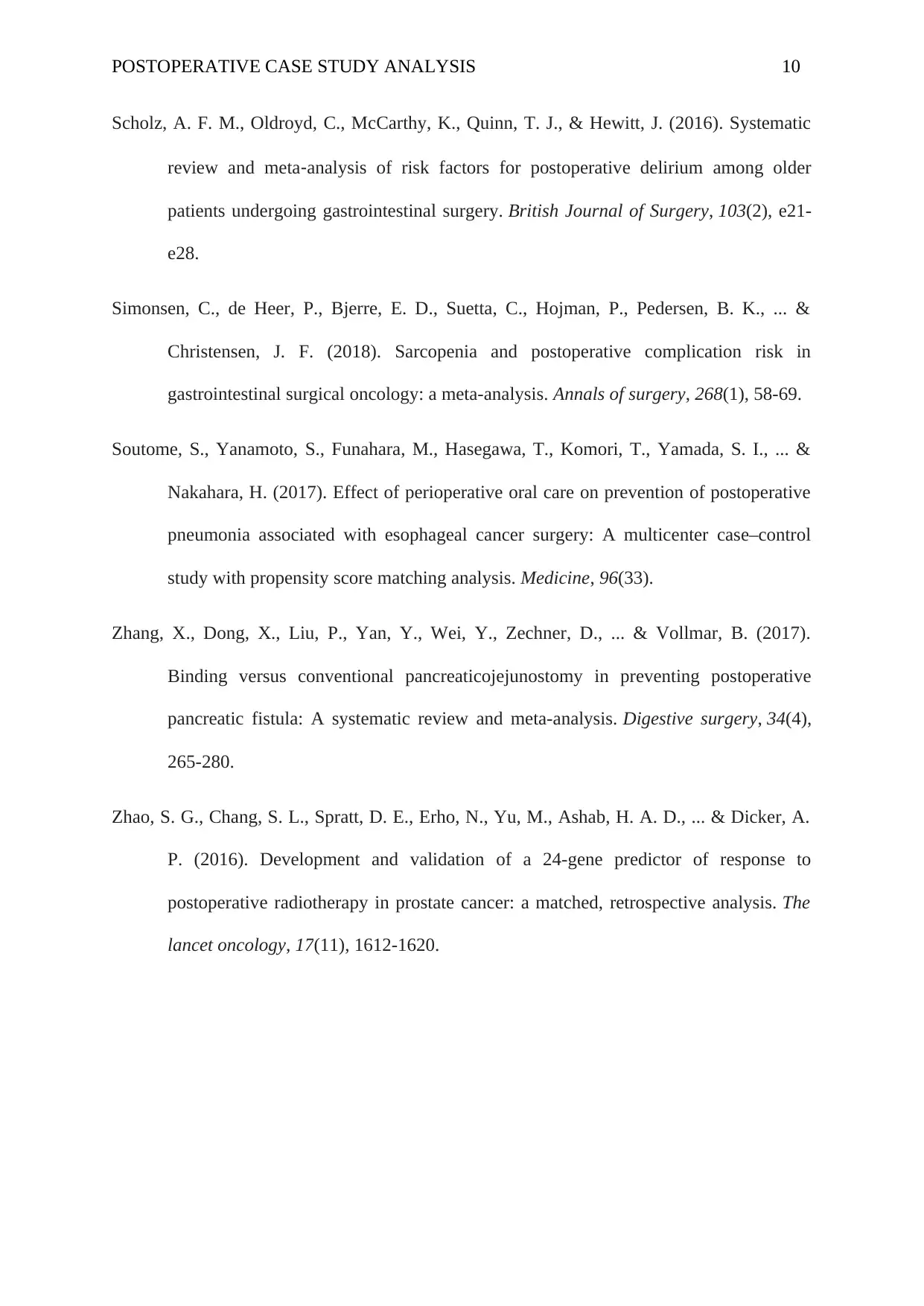
POSTOPERATIVE CASE STUDY ANALYSIS 10
Scholz, A. F. M., Oldroyd, C., McCarthy, K., Quinn, T. J., & Hewitt, J. (2016). Systematic
review and meta‐analysis of risk factors for postoperative delirium among older
patients undergoing gastrointestinal surgery. British Journal of Surgery, 103(2), e21-
e28.
Simonsen, C., de Heer, P., Bjerre, E. D., Suetta, C., Hojman, P., Pedersen, B. K., ... &
Christensen, J. F. (2018). Sarcopenia and postoperative complication risk in
gastrointestinal surgical oncology: a meta-analysis. Annals of surgery, 268(1), 58-69.
Soutome, S., Yanamoto, S., Funahara, M., Hasegawa, T., Komori, T., Yamada, S. I., ... &
Nakahara, H. (2017). Effect of perioperative oral care on prevention of postoperative
pneumonia associated with esophageal cancer surgery: A multicenter case–control
study with propensity score matching analysis. Medicine, 96(33).
Zhang, X., Dong, X., Liu, P., Yan, Y., Wei, Y., Zechner, D., ... & Vollmar, B. (2017).
Binding versus conventional pancreaticojejunostomy in preventing postoperative
pancreatic fistula: A systematic review and meta-analysis. Digestive surgery, 34(4),
265-280.
Zhao, S. G., Chang, S. L., Spratt, D. E., Erho, N., Yu, M., Ashab, H. A. D., ... & Dicker, A.
P. (2016). Development and validation of a 24-gene predictor of response to
postoperative radiotherapy in prostate cancer: a matched, retrospective analysis. The
lancet oncology, 17(11), 1612-1620.
Scholz, A. F. M., Oldroyd, C., McCarthy, K., Quinn, T. J., & Hewitt, J. (2016). Systematic
review and meta‐analysis of risk factors for postoperative delirium among older
patients undergoing gastrointestinal surgery. British Journal of Surgery, 103(2), e21-
e28.
Simonsen, C., de Heer, P., Bjerre, E. D., Suetta, C., Hojman, P., Pedersen, B. K., ... &
Christensen, J. F. (2018). Sarcopenia and postoperative complication risk in
gastrointestinal surgical oncology: a meta-analysis. Annals of surgery, 268(1), 58-69.
Soutome, S., Yanamoto, S., Funahara, M., Hasegawa, T., Komori, T., Yamada, S. I., ... &
Nakahara, H. (2017). Effect of perioperative oral care on prevention of postoperative
pneumonia associated with esophageal cancer surgery: A multicenter case–control
study with propensity score matching analysis. Medicine, 96(33).
Zhang, X., Dong, X., Liu, P., Yan, Y., Wei, Y., Zechner, D., ... & Vollmar, B. (2017).
Binding versus conventional pancreaticojejunostomy in preventing postoperative
pancreatic fistula: A systematic review and meta-analysis. Digestive surgery, 34(4),
265-280.
Zhao, S. G., Chang, S. L., Spratt, D. E., Erho, N., Yu, M., Ashab, H. A. D., ... & Dicker, A.
P. (2016). Development and validation of a 24-gene predictor of response to
postoperative radiotherapy in prostate cancer: a matched, retrospective analysis. The
lancet oncology, 17(11), 1612-1620.
1 out of 10
Related Documents
Your All-in-One AI-Powered Toolkit for Academic Success.
+13062052269
info@desklib.com
Available 24*7 on WhatsApp / Email
![[object Object]](/_next/static/media/star-bottom.7253800d.svg)
Unlock your academic potential
Copyright © 2020–2025 A2Z Services. All Rights Reserved. Developed and managed by ZUCOL.




